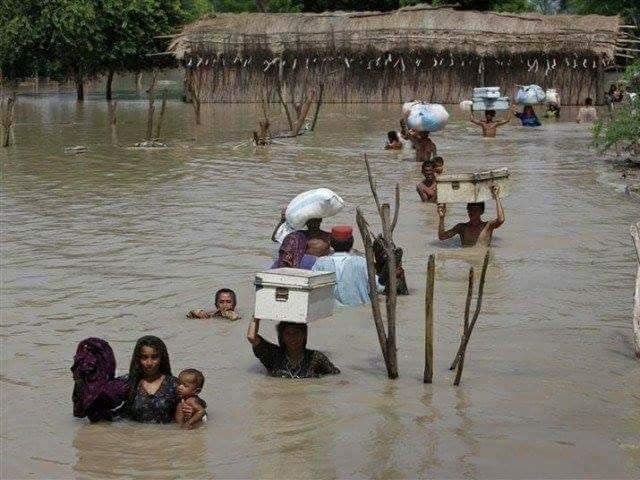By Shujauddin Qureshi
The floods that hit Pakistan in August 2022 were the worst in its history, affecting more than 33 million people, destroying millions of homes, and killing thousands of people. The province of Sindh was among the hardest hit, with more than 80 per cent of its land submerged by floodwaters in many districts.
Now, seven months later, the situation in Sindh remains dire, as millions of people are still living in temporary shelters, exposed to health risks, food insecurity, and loss of livelihoods. According to the United Nations Office for the Coordination of Humanitarian Affairs (OCHA), as of March 9, 2023, there were still 1.8 million people living near stagnant and contaminated water pools in Sindh.
The stagnant water seriously threatens public health, as it breeds mosquitoes and other vectors that transmit diseases such as malaria, dengue fever, and leishmaniasis. The water also contaminates the sources of drinking water and irrigation, leading to waterborne diseases such as diarrhoea, cholera, and typhoid. According to the World Health Organisation (WHO), more than 1.5 million cases of diarrhoea have been reported in Sindh since the floods. WHO signed a Memorandum of Understanding (MoU) with the provincial government on April 7 under which the UN body would rehabilitate 150 flood-hit primary healthcare centres in 21 districts in the province.
Floods and Children
The floods also had a devastating impact on the nutrition status of the population, especially children. According to UNICEF, more than 1.5 million children in Sindh are lacking services for severe acute malnutrition (SAM), a life-threatening condition that requires urgent treatment. Of these, 170,000 children are suffering from SAM with complications and need stabilization services that are not available in most of the affected areas.
The floods also destroyed the crops and livestock that were the main sources of income and food for millions of people in Sindh. According to the Food and Agriculture Organisation (FAO), more than 2.4 million hectares of cultivated land were damaged by the floods, affecting more than 5 million farmers. The loss of agricultural assets and income has pushed many people into deeper poverty and hunger.

Photo Courtesy: Radio Pakistan:
The humanitarian response to floods has been hampered by several challenges, such as access constraints, security issues, funding gaps, and coordination problems. The Pakistan Floods Response Plan, launched by the humanitarian community in September 2022, appealed for $816 million to provide life-saving assistance and early recovery support to 10 million people in need. However, as of March 9, 2023, the plan was only 52 per cent funded, leaving many critical needs unmet.
The people of Sindh need urgent and sustained support to recover from the floods and rebuild their lives. The humanitarian community is working with the government and local partners to assist in various sectors, such as health, nutrition, water, sanitation and hygiene (WASH), shelter, food security, agriculture, education, protection, and early recovery. However, more resources and efforts are needed to reach all those who need help and to prevent further deterioration of the situation.
The floods in Sindh have exposed the vulnerability of the province to climate change and natural disasters. The country needs to invest more in disaster risk reduction and climate change adaptation measures to enhance its resilience and preparedness for future shocks. The international community should also support Pakistan in addressing the root causes and long-term impacts of the floods, such as poverty, inequality, environmental degradation, and social unrest.
Corruption in International Aid for Flood Relief
The floods also exposed the deep-rooted corruption and mismanagement of foreign money that was meant to help the victims and rebuild the country.
According to a report by Transparency International, Pakistan ranked 124th out of 180 countries in the Corruption Perceptions Index 2022, with a score of 31 out of 100. The report highlighted that Pakistan’s public sector was plagued by bribery, nepotism, embezzlement, and political interference, which undermined the delivery of basic services and eroded public trust.
The corruption in foreign money during the 2022 floods in Pakistan was evident in several ways. First, there was a lack of transparency and accountability in the allocation and utilization of foreign aid and loans that were received from various sources, such as the International Monetary Fund (IMF), the World Bank, the Asian Development Bank (ADB), the European Union (EU), and other bilateral and multilateral donors. The government did not disclose how much money it received, how it spent it, or what results in it achieved. There were also allegations of favouritism, kickbacks, and misappropriation of funds by officials and contractors involved in relief and reconstruction activities.
Second, there was a lack of coordination and cooperation among different levels and agencies of the government, as well as between the government and civil society organizations. The federal and provincial governments often blamed each other for delays and failures in responding to the crisis. The National Disaster Management Authority (NDMA), which was supposed to lead and oversee the disaster management efforts, was ineffective and inefficient. The civil society organizations, which played a vital role in providing humanitarian assistance and advocacy, faced harassment and restrictions from the authorities.
Third, there was a lack of participation and empowerment of the affected communities and vulnerable groups, especially women, children, minorities, and persons with disabilities. The government did not consult or involve them in the planning, implementation, monitoring, or evaluation of the relief and reconstruction programs. The government also failed to protect their rights and interests, such as land tenure, property ownership, compensation, social protection, health care, education, and livelihood opportunities. The affected communities and vulnerable groups were often marginalized, discriminated against, or exploited by powerful actors.
The corruption in foreign money during the 2022 floods in Pakistan had serious consequences for the country’s economy, society, environment, and security. The corruption reduced the effectiveness and efficiency of the disaster response and recovery efforts, resulting in wastage of resources, poor quality of work, low satisfaction of beneficiaries, and low sustainability of outcomes. The corruption also increased inequality and poverty among the population, as well as distrust and resentment towards the government and donors. The corruption also exacerbated the environmental degradation and climate change impacts that caused the floods in the first place. The corruption also fueled social unrest and violence among groups competing for scarce resources.
The corruption in foreign money during the 2022 floods in Pakistan was a symptom of a deeper problem: a weak governance system that lacked transparency, accountability, participation, rule of law, and anti-corruption mechanisms. To address this problem, Pakistan needs to reform its governance system by strengthening its institutions, policies, laws, regulations, norms, values, and practices that promote good governance. Pakistan also needs to enhance its cooperation and coordination with its domestic and international partners to ensure that foreign money is used effectively and efficiently for disaster management. Pakistan also needs to empower its citizens and civil society organizations to participate actively and constructively in disaster management processes. Only then can Pakistan overcome the challenges posed by corruption in foreign money during the 2022 floods in Pakistan.
As we conclude this blog post, we want to emphasize some key points:
– The floods were caused by melting glaciers and record monsoons, both induced by climate change. Pakistan is one of the most vulnerable countries to climate change, ranking fifth on the Global Climate Risk Index 2020.
– The floods exposed the existing inequalities and vulnerabilities of the population, especially women, children, the elderly and persons with disabilities. Women faced challenges related to privacy, security, health and livelihoods. Children missed out on education and nutrition. The elderly and persons with disabilities faced difficulties in accessing relief and services.
– The floods also coincided with the COVID-19 pandemic, which posed additional risks and challenges for the affected population and the humanitarian response. The pandemic has affected more than 1.1 million people and claimed more than 25,000 lives in Pakistan as of March 2023.
– The humanitarian response to the floods was led by the Government of Pakistan, with support from national and international partners, including UN agencies, NGOs, civil society and donors. The response focused on providing life-saving assistance, such as food, water, shelter, health care and protection, as well as early recovery support, such as cash grants, livelihood restoration and rehabilitation of infrastructure.
– The recovery and resilience of the flood-affected population require long-term and sustainable interventions that address the root causes of vulnerability and enhance the adaptive capacity of communities and institutions. This includes investing in disaster risk reduction, climate change adaptation, social protection, gender equality, health systems strengthening and inclusive development.
We hope that this blog post has provided you with some useful information and insights on the floods in Sindh and their aftermath. We also hope that it has inspired you to take action to support the flood-affected population and to advocate for a more resilient and equitable future for Pakistan.
Photo Credit: Daily Express Tribune




